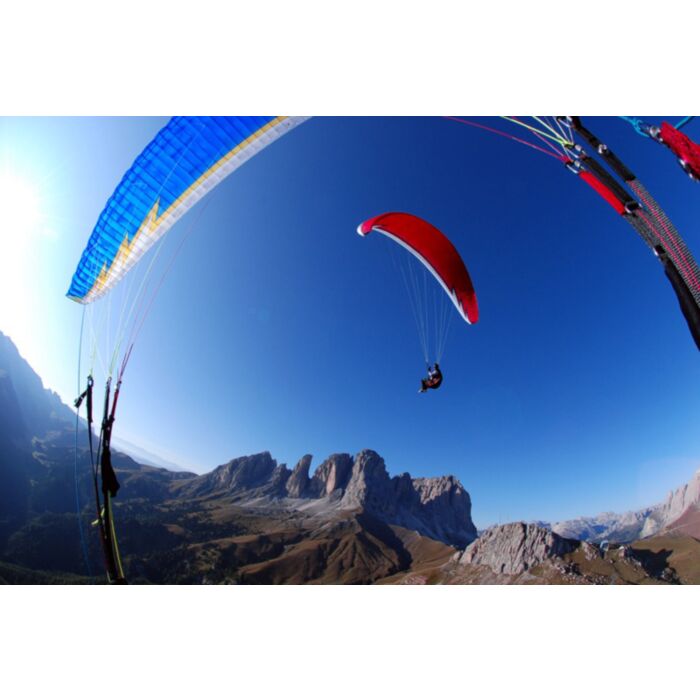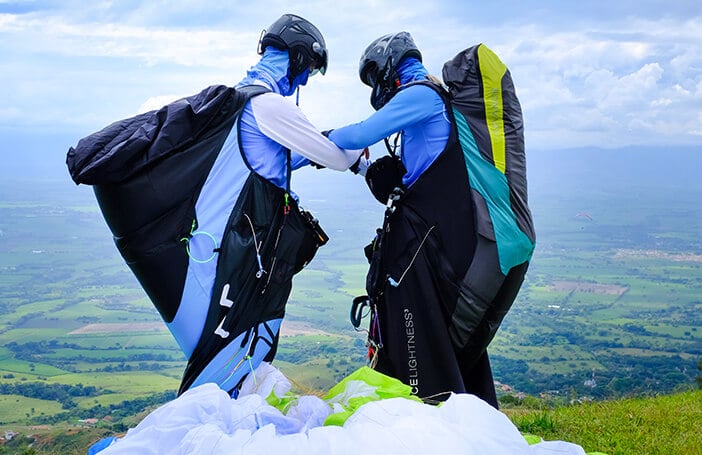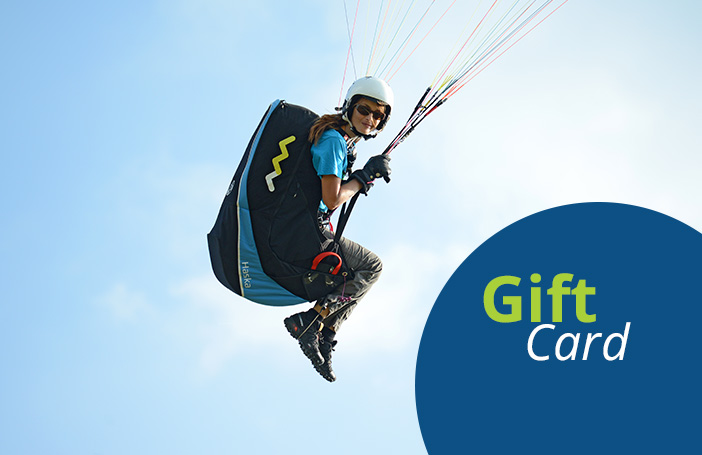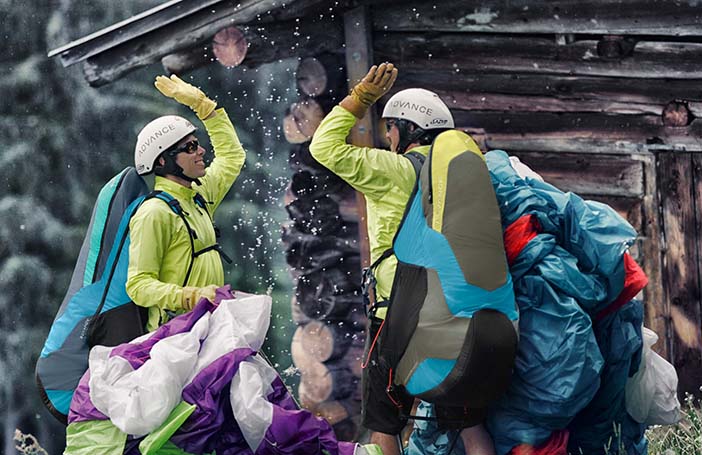
Nova Triton (PAST MODEL)
Select all options to view stock availability

Nova Triton Development:
With the TYCOON (LTF 2-3) we were able to set a standard within the segment of serial high performance wings. The wing is known for its high performance potential, combined with a manageable behaviour after collapses.
With the TRITON we wanted to continue this path and go a step further. The development was influenced significantly by our competition wing, the TRITON X. But the aims for those two gliders are quite different. So the TRITON is a completely separate construction.
One main issue at the beginning of development was an improvement of the handling characteristics over the TYCOON. We wanted to achieve an agile wing, with easy turning behaviour. Furthermore we wanted to turn our attention to easily manageable collapse behaviour, because if a pilot is overburdened by a wings reaction, he won’t be able to use the full performance potential, especially in difficult conditions.
Of course we wanted a considerable performance improvement, especially in accelerated flight, to meet the needs of ambitious XC-pilots.
During development we tried many prototypes with quite different concepts. We also worked with a radical concept with only three suspension levels (A, B, C) and a specially adapted airfoil. The performance was very promising but the reactions to collapses were too demanding for a certified performance glider. A few prototypes later we finally managed to get the performance of the three-line proto on a much higher safety level and better handling characteristics with 4 suspension levels.
The TRITON was born.
Flying the TRITON:
Anyone who expects a tough “high performance” handling characteristic will be surprised how playful and easy the wing can be piloted. With small brake inputs the TRITON can be thermalled very precisely, no matter how wide or narrow, flat or steep the glider is flown.
Advanced pilots will feel comfortable immediately and will therefore be able to use the full potential of the wing even in difficult conditions. The TRITON shows its handling strength best in narrow and strong thermals. It is surprisingly easy to bank up any time towards the centre of the thermals core.
But the TRITON is at its most impressive when dealing with flying accelerated through turbulent air. The wing is very stable and track adherent with an outstanding glide performance. The accelerator can be operated easily which allows effective correction of pitch movements with the speed bar, as well as flying accelerated for a long time without fatigue. The wings feedback stays precise during accelerated flight so threatening collapses can be foreseen and prevented.
Safety:
Outstanding performance data doesn’t make much sense if the pilot is overburdened in demanding conditions with the handling characteristics or with the wings reactions to collapses. That’s why we avoided sacrificing easy manageable flying characteristics for the maximum of glide performance.
Besides reaction to collapses, we think that precise handling characteristics are an important issue for safety as well: A wing, which can be flown exactly like the pilot wants, is a lot safer, than a glider, that can’t be flown precisely – especially for skilled pilots.
The other issue is of course the collapse behaviour. The TRITON is characterised by a very stable wing. Especially the centre of the wing hardly collapses. But of course, big collapses can occur in very turbulent conditions. The TRITON can be stabilised quite easy with a dosed brake input and the collapsed side reopens fast. Also big frontal collapses open fast and certain with a little brake input. The TRITON doesn’t tend to have cravattes after collapses. But in this glider segment with such a high aspect ratio, cravattes can happen after big collapses, however, learning the full stall recovery method from cravattes is recommended when flying this level of wing.
Performance:
In XC flying it is mainly the accelerated glide performance in turbulent air, which counts. We followed new paths in terms of airfoil and sail tension to maximise this performance characteristic. The result is a considerable higher maximum speed than on the TYCOON with clearly higher glide ratio in accelerated flight in calm air.
In turbulent conditions the performance advantage for the TRITON is even bigger.
Due to the precise handling characteristics the climb ability of the TRITON is very good – especially in demanding conditions.
Technical changes:
The following characteristics have been changed, compared to the TYCOON, its predecessor:
- Higher wing curve and shorter lines: This leads to higher sail tension as well as better and more direct handling characteristic in turns.
- Airfoil: With a new airfoil we could combine excellent performance with managable collapse behaviour.
- Integrated vector band: Like on the FACTOR and TRITON X we use an integrated vector band on the bottom sail at the cell openings to maximise the dimensional stability in this critical area.
- Less line radius: Because of the shorter distance between pilot and canopy, the handling of the wing is more direct and the pitching movement in rough air is reduced.
- Adapted sail tension: We made a lot of effort to maximise the accelerated flight performance. The sail tension has proven to be very important for this issue to avoid the deforming of the wing.
What stayed the same:
- Suspension concept: 3 stem lines with a C/D fork in the top cascade.
- Flat aspect ratio
Main characteristics:
The TRITON is a serial high performance glider certified with LTF 2-3 / EN D and combines outstanding performance with a very balanced and precise handling characteristic.
The performance of the TRITON could only be found on competition wings a short time ago. Now the same performance can be used with a playful handling and a relaxing safety potential.
The TRITON opens up new vistas for advanced cross country pilots because of the high performance potential combined with a safety level which is remarkable in this glider segment.
Nova Triton > Sizes & Weight Ranges
Here below are the sizes and weight ranges for the Nova Triton...
| Size | All-Up Weight Range |
| 20 | 80 - 105 kg |
| 22 | 90 - 115 kg |
| 24 | 100 - 130 kg |
Colours
Standard Colours: Blue Splash; Burning Sun; Red Baron; White Spider.
| Condition | New |
|---|---|
| EN Certification | EN C, EN D |
| LTF Certification | LTF 2-3 |
| Model Status | Past model |
Standard UK delivery - £3.95 / FREE on orders over £100.
Outside the UK - delivery calculated at checkout (based on the total order value and your delivery address).
We use Royal Mail, Parcelforce Worldwide and other courier companies (e.g. DHL, DPD) depending on shipment value, weight, destination etc.
For more information, please view our order and delivery FAQs page.
If you are not 100% satisfied with your order, you have 14 days from the day of delivery to request a refund.
Delivery costs will not be refunded and you will be responsible for the delivery cost to return the order.
For more information, please read our returns and exchanges policy.



